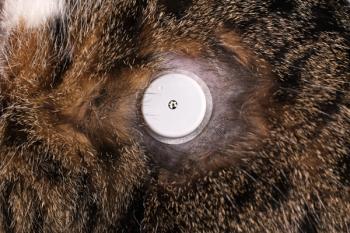
What's new with hypothyroidism in dogs (Proceedings)
Hypothyroidism is a common endocrine disorder of middle-aged, purebred dogs resulting in decreased production of the thyroid hormones, thyroxine (TT4) and tri-iodothyronine (T3) from the thyroid gland. The majority is believed to be due to acquired primary hypothyroidism.
What we know
Hypothyroidism is a common endocrine disorder of middle-aged, purebred dogs resulting in decreased production of the thyroid hormones, thyroxine (TT4) and tri-iodothyronine (T3) from the thyroid gland. The majority is believed to be due to acquired primary hypothyroidism. Destruction of the thyroid gland can result from autoimmune lymphocytic thyroiditis, idiopathic thyroid atrophy, or more rarely, neoplastic invasion. Secondary hypothyroidism is rare.
Autoimmune lymphocytic thyroiditis is common in some breeds (English Setters, old English sheepdogs, boxers, giant schnauzers and American pit bull terriers) as evidenced by thyroglobulin autoantibodies (TgAA). Hypothyroidism in some breeds is commonly associated with TgAA while others have a lower prevalence. For example only 26% of Doberman pinschers are positive for TgAA compared to 69% of golden retrievers. A TgAA-positive does not provide any assessment of thyroid function, only that thyroiditis is present. Dogs with positive TgAA tests should have thyroid function monitored every 6 – 12 months. There is no scientific evidence that vaccination induces autoimmune thyroid disease.
In hypothyroid dogs, basal metabolism is slowed as evidenced by lethargy, weight gain, and exercise intolerance. These signs gradually appear so owners attribute changes to aging. Dermatologic changes are common including dry, scaly skin, changes in haircoat quality or color, alopecia, seborrhea sicca or oleosa, and superficial pyoderma. Neurological manifestations are occasionally present. Generalized polyneuropathy is displayed as generalized weakness, ataxia, and hyporeflexia. Central nervous signs occur, with central vestibular signs most common.
Clinical suspicion of canine hypothyroidism should be obtained by evaluation of the history, physical and blood test results. A complete blood count (CBC), serum chemistry profile (SMA) and urinalysis, as well as measurement of TT4 and TSH concentration should be obtained. The CBC may reveal normocytic, normochromic, and non-regenerative anemia. The SMA might have fasting hypertriglyceridemia and hypercholesterolemia because thyroid hormones stimulate virtually all aspects of lipid metabolism, with decreased degradation affected mostly with the net effect of plasma lipid accumulations.
For routine cases of suspected hypothyroidism, serum concentrations of TT4 and TSH are recommended at a minimum. Decreased TT4 AND elevated TSH confirm the diagnosis, but do not occur in all cases. In the presence of non-thyroidal illness or uncommon clinical signs a serum free T4 (fT4) should be measured by equilibrium dialysis.
Total T4 is a sensitive but not specific test for diagnosing hypothyroidism. Although the majority of hypothyroid dogs have low TT4 levels, some normal dogs with other illnesses have low TT4 levels as well. And it is important to use a veterinary laboratory as dogs have a much lower range of TT4 than humans so non-veterinary laboratories do not accurately measure TT4.
Serum T3 concentration is an unreliable test for evaluation of thyroid function as some studies tout almost 90% of hypothyroid dogs have a normal serum T3 concentration.
What's new?
In the last few years' new studies have provided new information affecting the diagnosis and management of canine hypothyroidism. The rest of this lecture discusses the clinical implications of the recent studies and includes direct citations from the references articles.
• Williams DL, Pierce V, et al. Reduced tears production in three canine endocrinopathies. J Small Anim Pract 2007; 48(5): 252-256.
- Previous reports suggest hypothyroid (and diabetic) patients can be predisposed to keratoconjunctivitis sicca (KCS). This study measured teat production in dogs with hypothyroidism (along with diabetes and hyperadrenocorticism). Schirmer tear tests were significantly lower than that for the control group in all dogs with an endocrinopathy. This study showed significant reduction in tear production in animals with hypothyroidism (along with diabetes and hyperadrenocorticism). Further studies are needed to elucidate the mechanism of decreased tear production. All animals with endocrinopathies should have their tear production monitored as these animals may progress to clinical KCS.
• Brenner K, Harkin K, Schermerhorn T. Iatrogenic, sulfonamide-induced hypothyroid crisis in a Labrador retriever. Aust Vet J 2009; 50(8): 503-5.
- A four-year old, intact female Labrador retriever received empirical therapy with high-dose trimethoprim-sulfamethoxazole for ten days. She presented for weakness, ataxia, and mental depression. The clinicopathological results supported hypothyroid-induced central nervous system depression. Short-term levothyroxine sodium therapy led to complete resolution of all clinical signs. Follow-up thyroid hormone assays ruled-out underlying thyroid pathology. This is the first report to highlight this potentially life-threatening manifestation of sulfonamide-induced hypothyroidism. Sulfonamide combinations are widely used antimicrobials in veterinary medicine.
• Segalini V, Hericher T, et al. Thyroid function and infertility in the dog: a survey in five breeds. Reprod Domest Anim 2009; 50(8): 828-34.
- Two hundred and four dogs of five different breeds received a clinical and reproductive examination. Thyroxine (TT4) and thyroid-stimulating hormone (TSH) plasma concentrations were assayed in order to assess the real incidence of hypothyroidism associate with reproductive disease. Among these only two breeds were affected by hypothyroidism (2.4% of the Leonbergers and 4.5% of the Dogue de Bordeaux). Moreover, these dogs did not suffer from any reproductive disease. Their study also showed that 70% of the Dogue de Bordeaux (male and female) were hypothyroid compared with Great Danes, English Mastiff, and Leonbergers, whose population were normo-thyroid. There was no difference in thyroxine plasma concentrations between normo- and hypofertile dogs (but results were not statistically significant).
• Rossmeisl JH, Duncan RB, et al. Longitudinal study of the effects of chronic hypothyroidism on skeletal muscle in dogs. Am J Vet Res 2009; 70(7): 879-889.
- Nine female adult mixed-breed dogs received 131 I to experimentally induce hypothyroidism were compared to 3 untreated control dogs. Clinical examinations were performed monthly Prior to and every six months for 18 months after induction of hypothyroidism; electromyographic studies, measurement of plasma creatine kinase and skeletal muscle morphologic-morphometric examinations were performed. Hypothyroid dogs developed electromyographic and morphologic evidence of myopathy by six months, which persisted throughout the study, although these changes were subclinical at all times. Hypothyroid myopathy was associated with significant increases in plasma creatine kinase, aspartate aminotransferase, and lactate dehydrogenase and was characterized by nemaline rod inclusions, substantial and progressive predominance of type I my fibers, decrease in mean type II fiber area, sarcolemmal accumulations of abnormal mitochondria and myofiber degeneration. Chronic hypothyroidism was associated with substantial depletion in skeletal free muscle carnitine. This study documented in experimentally-induced hypothyroidism, substantial but subclinical phenotypic myopathic changes indicative of altered muscle energy metabolism and depletion of skeletal muscle carnitine. This may contribute to the nonspecific clinical signs such as lethargy and exercise intolerance often reported in hypothyroid dogs.
• Gommeren K, van Hoek I, et al. Effect of thyroxine supplementation on glomerular filtration rate in hypothyroid dogs. J Vet Intern Med 2009; 23(4): 844-849.
- Research about kidney function in hypothyroid dogs is lacking. Their objective was to assess GFR in hypothyroid dogs before implementation of thyroxine supplementation and after re-establishing euthryoidism. Fourteen hypothyroid dogs with normal urinalysis and ultrasound examination were entered. Blood pressure and GFR were measured before treatment and at one and six months after beginning levothyroxine supplementation therapy (20 microg/kg/d PO). The response to therapy was monitored and medication was adjusted based upon measurement of TT4 and TSH concentrations. Their conclusion was that GFR was less than 2 mL/min/kg in untreated hypothyroid dogs compared to the normal 3-5 mL/min/kg. Re-establishment of a euthyroid state increased GFR significantly.
• LeTraon G, Brennan SF, et al. Clinical evaluation of a novel liquid formulation of L-thyroxine for once-daily treatment of dogs with hypothyroidism. J Vet Intern Med 2009; 23(1): 43-49.
- A liquid solution of levothyroxine (L-T4) is now available for treatment of canine hypothyroidism. Thirty-five dogs with naturally occurring hypothyroidism started receiving L-T4 solution orally at a starting dosage of 20 microg/kg body weight (BW). The dose was adjusted every four weeks, based on clinical signs and peak serum TT4 concentrations. The dogs were followed for up to 22 weeks after the establishment of the maintenance dose. Clinical sign of hypothyroidism improved or resolved in 91% of dogs after four weeks of L-T4 treatment at 20 microg/kg once daily. The maintenance dose was established in 76, 94 and 100% of dogs after four, eight and 12 weeks of treatment, respectively. This was 20 microg/kg BW for 79% of the dogs, 30 microg/kg for 15% and 10-15 microg/kg BW in the remaining 6%, once daily. Thereafter median peak of TT4 and TSH concentrations remained stable during the 22 weeks. This study showed that all hypothyroid dogs had rapid, clinical and hormonal responses to oral L-T4 supplementation. A suitable starting dose is 20 microg/kg BW.
• Foley C, Bracker K, Drellich S. Hypothalamic-pituitary axis deficiency following traumatic brain injury in a dog. J Vet Emerg Crit Care 2009; 19(3): 269-274.
- A twelve-week old dog was presented with traumatic brain injury and did not respond to traditional supportive care. Continued hypothermia, electrolyte derangements, hypotension, and hyposthenuria prompted screening for and detection of several hypothalamic-pituitary disorders such as hypoadrenocorticism, central diabetes insipidus, hypothyroidism, and growth hormone deficiency. Electrolyte abnormalities, urine osmolarity and blood pressure improved with treatment for the associated disorders. This is the first report of generalized hypothalamic-pituitary dysfunction following traumatic brain injury in a dog.
• Vitale CL, Olby NJ. Neurologic dysfunction in hypothyroid, hyperlipidemic Labrador retrievers. J Vet Intern Med 2007; 21(6): 1316-1322.
- The mechanism for hypothyroid-associated neurologic signs is not understood. Hypothyroidism is also associated with hyperlipidemia that predisposes to atherosclerosis, increased blood viscosity and thromboembolic events. Retrospectively three Labrador retrievers fit the inclusion criteria of hypothyroidism and severely hyperlipidemic. Neurologic signs included paraparesis, tetraparesis, central and peripheral vestibular signs, and facial paralysis. Two dogs had an acute history and rapid resolution of signs consistent with an infarct, the presence which was confirmed in one of the dogs by magnetic resonance imaging. One dog had evidence of iliac thrombosis and atherosclerosis on ultrasound examination. Clinical relevance shows Labrador retrievers may be predisposed to the development of severe hyperlipidemia in association with hypothyroidism. One possible consequence of severe hyperlipidemia is the development of neurologic signs due to atherosclerosis and thromboembolic events.
References available on request
Newsletter
From exam room tips to practice management insights, get trusted veterinary news delivered straight to your inbox—subscribe to dvm360.




